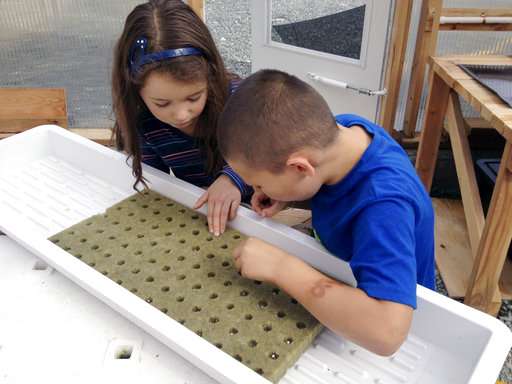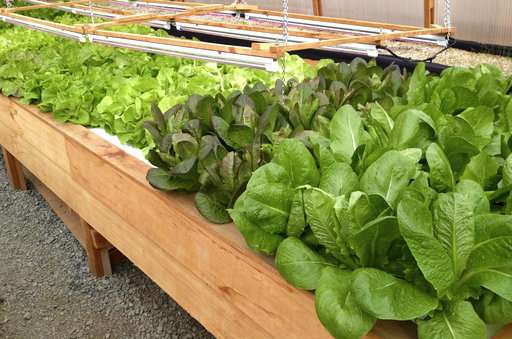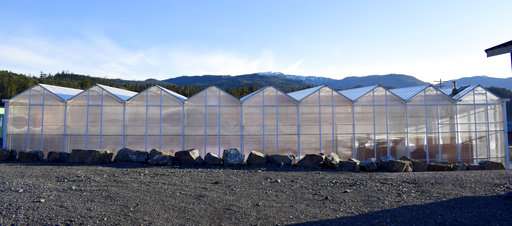Alaska counters lack of fresh veggies with greenhouse guide

Cold-climate greenhouses have long been an option for increasing the limited growing season in Alaska, where fresh produce is a rarity in a harsh environment. But for many remote communities that rely on costly imported diesel fuel for their power source, they're too expensive to operate.
Now, the state has released a handbook that shows schools and community groups how to build greenhouses heated with a plentiful local resource: wood.
The 98-page guide comes as greenhouses gain popularity in the vast state for several reasons, including improved technology and heightened awareness, according to officials who worked on the handbook.
Thousands of schools in the lower 48 have gardens and some have greenhouses where students learn to grow food. But Alaska's situation is unique given the lack of fresh produce from local sources in remote parts of the state.
"There's nobody that comes close," says Bob Deering, renewable energy coordinator for the Alaska region of the U.S. Forest Service, the handbook's main funding source.
In villages off the state's limited road system, for instance, goods must be flown up or barged in. Steeply priced vegetables can be more than a week in transit and past their prime by the time they arrive at stores.
The new handbook covers a range of subjects—from community planning and funding options to types of greenhouses and management of plant nutrients—aimed at putting more locally grown food in Alaska kitchens and school cafeterias. It also contains curriculum and case studies of projects by several schools, including the one in the small Prince of Wales Island community of Thorne Bay, in southeast Alaska, which installed a 750-square-foot (70-square-meter) aquaponics greenhouse three years ago.
The school was able to cheaply heat its greenhouse year-round with cord wood cut by students. Wood and variations such as cord wood, wood chips and pellets are known in the industry as biomass.
"They could never have afforded a greenhouse if they were heating their school with diesel heat," said Devany Plentovich, manager of the Alaska Energy Authority's biomass program.

A year in the making, the guide was funded by federal and state grants totaling $150,000. It involved input from multiple entities, including those with successful projects such as Thorne Bay, whose heating system was funded through the state biomass program.
Inefficient wood-burning stoves and outdoor boilers have created a huge pollution problem in Fairbanks. The boilers used in the greenhouses, however, are far more efficient, burning most of the pollution that otherwise would go into the atmosphere, thanks to a second combustion chamber absent in less sophisticated systems, officials say.
The Thorne Bay school was the first of four in the Southeast Island School District to install wood-heated aquaponics greenhouses, which use live fish to provide nutrients for lettuce, kale, bok choy and other crops.
Alaska bans fish farming so the schools can't use edible fish such as aquaponics-favorite tilapia. They instead rely on goldfish and koi, said district greenhouse manager Colter Barnes, who also is the principal at the school in Coffman Cove, a community of 200.
Students in the district even have a business license with the state as "Island Fresh Student Enterprises," to sell their crops at farm stands and local businesses—whatever is left after the island's six schools get produce for cafeteria salad bars.
At the Coffman Cove school, all 20 students start their weekdays at their 7,000-square-foot (650-square-meter) greenhouse, which has 10,000 plants and 2,000 fish. Students at all levels go through a list of chores, including testing the water, feeding the fish, and planting or checking crops.
The only thing the younger students don't do is load and fire up the wood-burning boilers. Students 16 and older get paid to cut and stack wood, and load the boilers, Barnes said.
He called the greenhouse program a work in progress that has been a hit with students.
"It's been fantastic. Kids love to eat, and kids love to make money," he said. "They are engaged in it—way more engaged than any worksheet or textbook."

In Coffman Cove, 12-year-old seventh-grader Damon Holtman went even further. He and his parents just built a small solar greenhouse at their property. An agriculture buff, Holtman also spends more time in the school greenhouse than any other student.
He said it's easier to remember lessons learned through hands-on experience. For example, calculating how much to feed the fish involves a lot of math.
"These fish eat 3 percent of their body weight," Damon said. "So we had to weigh the fish and average that out and then divide it between the four tanks and then estimate how many fish were in there."
In Thorne Bay, students even run an eight-table cafe in the town of 530 that features the greenhouse produce in such menu fare as burgers and salads.
Senior Aaliyah Follett, who has worked at the eatery for two years, said the local produce is vastly superior to the shipped-in "stuff" that can be wilted and marred by bugs.
"I noticed that with our greenhouse, we don't have an aphid problem," she said. "It's all really fresh and tastes really nice."
More information: Online: www.akenergyauthority.org/Port … GreenhouseManual.pdf
© 2017 The Associated Press. All rights reserved.


















